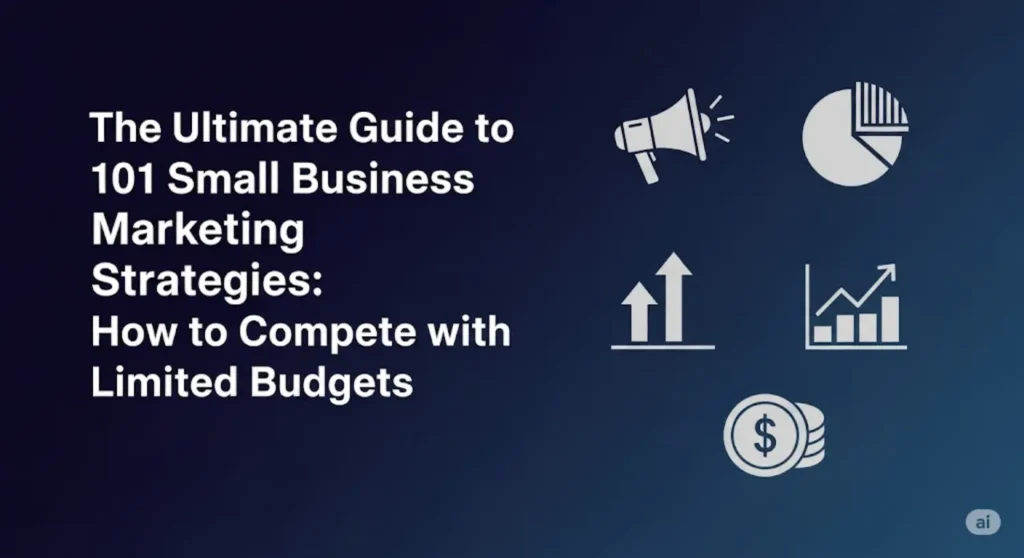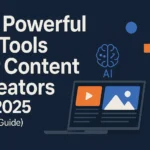Small Business Growth Through Targeted Marketing
These 25 small business marketing strategies are the lifeline for entrepreneurs looking to establish their online presence for small business success. Unlike large corporations with unlimited resources, small businesses must rely on cost-effective small business marketing strategies that maximize impact while minimizing spend.
This comprehensive guide reveals proven small business marketing strategies for local businesses and digital marketing for small business growth. You’ll discover low-budget marketing ideas, effective marketing techniques, and must-have tools to boost marketing efforts—all designed to help you compete effectively in today’s competitive marketplace using these powerful small business marketing strategies.
Foundation First: Building Your Marketing Strategy Framework
Understanding Your Target Market: The Key to Effective Small Business Marketing Strategies
Before implementing any small business marketing strategies, you need to understand exactly who you’re trying to reach. This targeted approach is how small businesses can compete with limited budgets against larger competitors.
Creating Detailed Customer Personas:
- Demographics: Age, gender, income level, education
- Psychographics: Values, interests, lifestyle preferences
- Behavioral patterns: Shopping habits, preferred communication channels
- Pain points: Problems your product or service solves
- Geographic location: Essential for local marketing strategies
Actionable Tip: Survey your best customers to gather real data. Use free tools like Google Forms or Typeform to collect insights about their preferences, challenges, and buying behaviors.
Crafting Your Value Proposition: Tips to Create a Strong Online Brand
Your value proposition is the foundation of all marketing ideas for entrepreneurs. It should clearly communicate how your business solves customer problems better than competitors.
The Value Proposition Formula: “We help [target audience] achieve [desired outcome] without [current frustration/obstacle].”
Real-World Example: Instead of saying “We provide accounting services,” try “We help small business owners stay tax-compliant and maximize deductions without spending hours on bookkeeping.”
Establishing Brand Identity: Branding for Startups on a Budget
Consistent branding for startups doesn’t require a massive budget—it requires strategic thinking and consistency across all touchpoints.
Essential Brand Elements:
- Logo and Visual Identity: Use tools like Canva for professional-looking designs
- Color Palette: Choose 2-3 colors that reflect your brand personality
- Typography: Select readable fonts that work across digital and print materials
- Brand Voice: Define how you communicate (professional, friendly, authoritative, etc.)
- Brand Guidelines: Create a simple document outlining usage rules
Digital Small Business Marketing Strategies: Core Growth Tactics
1. SEO-Focused Small Business Marketing Strategies: Building Long-Term Visibility
Search engine optimization is one of the most cost-effective small business marketing strategies for sustainable growth. SEO for small businesses focuses on local search optimization and long-tail keyword targeting.
Local SEO Essentials:
- Google Business Profile Optimization: Complete all fields, add photos, collect reviews
- Local Keyword Targeting: Include city/region names in your content
- NAP Consistency: Ensure Name, Address, Phone number match across all directories
- Local Content Creation: Write about local events, partnerships, community involvement
Content Marketing Tips for SEO:
- Answer common customer questions through blog posts
- Create comprehensive guides related to your industry
- Use local keywords naturally in your content
- Optimize for mobile devices (over 60% of searches are mobile)
Low-Budget SEO Tools:
- Google Search Console (free)
- Google Keyword Planner (free)
- Ubersuggest (freemium)
- Answer The Public (freemium)
2. Social Media Small Business Marketing Strategies: Building Community

Social media marketing for small business success requires choosing the right platforms and creating engaging content consistently. These small business marketing strategies focus on authentic engagement rather than follower count.
Platform Selection Strategy:
- Facebook: Best for local businesses and community building
- Instagram: Ideal for visual products and younger demographics
- LinkedIn: Essential for B2B companies and professional services
- TikTok: Perfect for reaching Gen Z and millennials with creative content
Customer Engagement Ideas for Social Media:
- Behind-the-scenes content showing your team and processes
- User-generated content campaigns with branded hashtags
- Live Q&A sessions addressing customer questions
- Customer spotlight features and success stories
- Educational content that provides genuine value
Cost-Effective Social Media Strategy:
- Post consistently rather than frequently (quality over quantity)
- Repurpose content across multiple platforms
- Engage authentically with comments and messages
- Use free scheduling tools like Buffer or Hootsuite’s free tier
3. Email Marketing Campaigns: Direct Customer Communication
Email marketing remains one of the highest ROI marketing channels, making it perfect for inbound marketing for small business growth.
Lead Generation Tactics Through Email:
- Lead Magnets: Offer valuable resources (guides, checklists, templates) in exchange for email addresses
- Newsletter Sign-ups: Provide exclusive tips, industry insights, or early access to promotions
- Exit-Intent Popups: Capture visitors before they leave your website
- Content Upgrades: Offer additional resources related to specific blog posts
Email Campaign Types:
- Welcome Series: Introduce new subscribers to your brand and values
- Educational Newsletters: Share industry insights and helpful tips
- Product Announcements: Showcase new offerings to existing customers
- Re-engagement Campaigns: Win back inactive subscribers with special offers
Email Marketing Tools for Small Businesses:
- Mailchimp: Free tier for up to 2,000 contacts
- ConvertKit: Designed for creators and small businesses
- Constant Contact: User-friendly with excellent templates
- HubSpot: Free CRM with email marketing capabilities
4. Content Marketing: Building Trust and Authority
Content marketing is essential for how to promote a small business effectively while establishing expertise and trust.
Content Types That Drive Results:
- Blog Posts: Answer customer questions and improve SEO
- Video Content: Product demonstrations, tutorials, behind-the-scenes
- Infographics: Make complex information digestible and shareable
- Case Studies: Showcase real-world examples of marketing success
- Podcasts: Build deeper connections with your audience
Leveraging Content to Build Trust and Authority:
- Share actionable tips that customers can implement immediately
- Tell stories about how you’ve helped other customers succeed
- Be transparent about your processes and business values
- Respond to comments and engage in conversations
- Collaborate with other local businesses on content
Low-Budget Marketing Ideas: Maximum Impact, Minimum Spend
1. Local Marketing Strategies: Community-Focused Growth
Local marketing strategies are particularly effective for service-based businesses and retail operations.
Community Engagement Tactics:
- Local Event Sponsorship: Support community events within your budget
- Chamber of Commerce Membership: Network with other local business owners
- Local Media Partnerships: Offer expert commentary on industry topics
- Charity Involvement: Support causes that align with your brand values
Grassroots Marketing Approaches:
- Word-of-Mouth Campaigns: Create remarkable experiences that customers naturally share
- Referral Programs: Incentivize existing customers to bring in new business
- Local Partnership Marketing: Cross-promote with complementary businesses
- Community Workshop Hosting: Share your expertise through free educational events
2. Guerrilla Marketing: Creative, Low-Cost Tactics
These unconventional approaches can generate significant buzz without large budgets.
Creative Marketing Ideas:
- Flash Mob Events: Organize attention-grabbing performances in high-traffic areas
- Chalk Art Campaigns: Create temporary art that promotes your business
- QR Code Treasure Hunts: Hide codes around town that lead to discounts
- Pop-Up Shops: Set up temporary locations in high-traffic areas
3. Partnership Marketing: Collaborative Growth
How small businesses can compete with limited budgets often involves strategic partnerships.
Partnership Opportunities:
- Cross-Promotional Campaigns: Exchange email list promotions with complementary businesses
- Joint Webinars: Share expertise and audiences with industry partners
- Bundled Offerings: Create package deals with related service providers
- Affiliate Programs: Offer commissions for successful referrals
Small Business Advertising: Paid Strategies That Work
1. Google Ads for Small Business: Targeted Local Advertising
Google Ads can be highly effective when implemented strategically with small budgets.
Smart Google Ads Strategies:
- Start with Branded Keywords: Protect your brand name and capture high-intent searches
- Use Location Targeting: Focus on your service area to avoid wasted spend
- Long-Tail Keywords: Target specific phrases with less competition
- Ad Extensions: Include location, phone, and site link extensions for better visibility
Budget Management Tips:
- Start with $20-50 per day and scale successful campaigns
- Use dayparting to show ads only during business hours
- Set up negative keywords to avoid irrelevant clicks
- Monitor search terms reports weekly for optimization opportunities
2. Social Media Advertising: Targeted Audience Reach
Social media advertising allows precise targeting at lower costs than traditional advertising.
Facebook and Instagram Ads:
- Lookalike Audiences: Target people similar to your best customers
- Retargeting Campaigns: Reach people who visited your website
- Local Awareness Ads: Target people within a specific radius of your business
- Video Ads: Higher engagement rates than static images
LinkedIn Advertising (B2B Focus):
- Target by job title, industry, and company size
- Use lead generation forms for easy contact capture
- Sponsor content that has already performed well organically
Marketing Tools for Small Businesses: Essential Technology Stack
Free Marketing Tools
Analytics and Tracking:
- Google Analytics: Website traffic analysis and user behavior insights
- Google Search Console: SEO performance monitoring and optimization
- Facebook Insights: Social media performance tracking
- Hotjar: User behavior analysis with heatmaps and recordings
Content Creation:
- Canva: Professional graphic design templates
- Unsplash/Pexels: Free stock photography
- OpenShot/DaVinci Resolve: Free video editing software
- Grammarly: Writing assistance and proofreading
Social Media Management:
- Buffer: Schedule posts across multiple platforms
- Hootsuite: Comprehensive social media management
- Later: Visual content calendar and scheduling
Paid Marketing Tools Worth the Investment
All-in-One Platforms:
- HubSpot: CRM, email marketing, and marketing automation
- Mailchimp: Email marketing with advanced segmentation
- Klaviyo: E-commerce focused email and SMS marketing
Specialized Tools:
- SEMrush/Ahrefs: Advanced SEO and competitor analysis
- ConvertKit: Creator-focused email marketing
- Leadpages: Landing page creation and optimization
Marketing Automation for Small Business: Efficiency and Scale
Setting Up Basic Automation
Marketing automation for small business doesn’t have to be complex or expensive.
Essential Automation Workflows:
- Welcome Email Series: Automatically introduce new subscribers to your brand
- Abandoned Cart Recovery: Re-engage customers who left items in their online cart
- Birthday/Anniversary Campaigns: Personalized offers for special occasions
- Lead Nurturing Sequences: Educate prospects through the buying journey
Social Media Automation:
- Schedule posts in advance during peak engagement times
- Auto-respond to common questions on Facebook and Instagram
- Set up Google Alerts for brand mentions to respond quickly
How to Attract and Retain Customers Through Automation
Customer Retention Automation:
- Post-Purchase Follow-up: Thank customers and ask for reviews
- Loyalty Program Management: Automatically reward repeat customers
- Win-Back Campaigns: Re-engage customers who haven’t purchased recently
- Personalized Product Recommendations: Based on purchase history
Small Business Marketing Plan: Creating Your Strategy
Phase 1: Planning and Research (Month 1)
Market Research Activities:
- Analyze competitor marketing strategies and identify gaps
- Survey existing customers about their preferences and pain points
- Research keyword opportunities for SEO and content marketing
- Set up tracking systems (Google Analytics, social media insights)
Goal Setting:
- Define specific, measurable marketing objectives
- Set realistic budgets for each marketing channel
- Create customer acquisition cost targets
- Establish timeline for implementing different strategies
Phase 2: Foundation Building (Months 2-3)
Website and SEO Optimization:
- Optimize website for mobile and page speed
- Create Google Business Profile and optimize for local search
- Set up basic SEO structure and begin content creation
- Install tracking codes and conversion tracking
Content Creation:
- Develop content calendar for blog posts and social media
- Create lead magnets for email list building
- Design brand assets and marketing materials
- Begin email marketing automation setup
Phase 3: Implementation and Growth (Months 4-6)
Channel Activation:
- Launch social media marketing campaigns
- Begin consistent content publishing schedule
- Start email marketing campaigns and list growth
- Test small paid advertising campaigns
Optimization and Scaling:
- Analyze performance data and optimize underperforming areas
- Scale successful campaigns and channels
- Refine targeting and messaging based on results
- Expand to additional marketing channels as budget allows
Phase 4: Advanced Strategies (Months 7-12)
Advanced Tactics:
- Implement marketing automation workflows
- Launch referral and loyalty programs
- Develop strategic partnerships and collaborations
- Create advanced content like webinars or podcasts
Real-World Examples of Marketing Success
Case Study 1: Local Service Business
Business: Home cleaning service Challenge: Limited budget competing against franchises Strategy: Focused on local SEO, customer referrals, and community involvement
Results:
- 300% increase in organic website traffic through local SEO
- 40% of new customers from referral program
- Featured in local media through community involvement
- Average customer acquisition cost: $15 (vs. $75 for paid ads)
Case Study 2: E-commerce Startup
Business: Handmade jewelry Challenge: Building brand awareness in saturated market Strategy: Social media marketing, influencer partnerships, email marketing
Results:
- Built email list of 10,000 subscribers in 8 months
- Generated $50,000 in revenue through email marketing campaigns
- Achieved 25% of sales through social media channels
- Collaborated with 15 micro-influencers for authentic promotion
Case Study 3: B2B Professional Services
Business: Marketing consulting firm Challenge: Establishing authority in competitive market Strategy: Content marketing, LinkedIn networking, webinar hosting
Results:
- Blog traffic increased 500% through SEO-optimized content
- Generated 200+ qualified leads through educational webinars
- Built LinkedIn following of 5,000+ industry professionals
- Average deal size increased 60% through authority building
Common Mistakes to Avoid
1. Spreading Efforts Too Thin
Many entrepreneurs try to be active on every platform simultaneously. Instead:
- Choose 2-3 marketing channels to focus on initially
- Master each channel before expanding to new ones
- Allocate 80% of effort to proven strategies, 20% to testing new approaches
2. Neglecting to Track Results
Without proper measurement, you can’t optimize your marketing investments:
- Set up conversion tracking from day one
- Review performance metrics monthly
- Calculate customer acquisition cost for each channel
- Use UTM parameters to track campaign performance
3. Inconsistent Brand Messaging
Mixed messages confuse potential customers and dilute brand impact:
- Develop clear brand guidelines and stick to them
- Ensure all team members understand your value proposition
- Regular audit all marketing materials for consistency
- Train staff on brand voice and customer communication standards
4. Ignoring Customer Feedback
Your customers provide valuable insights for marketing optimization:
- Regularly survey customers about their experience
- Monitor online reviews and respond professionally
- Use customer language in your marketing copy
- Address common concerns proactively in your content
Measuring Success: Key Performance Indicators
Traffic and Awareness Metrics
Website Performance:
- Monthly organic traffic growth
- Pages per session and average session duration
- Mobile traffic percentage and user experience
- Local search ranking positions
Social Media Metrics:
- Follower growth rate across platforms
- Engagement rate (likes, comments, shares)
- Reach and impressions for content
- Click-through rates to website
Conversion and Revenue Metrics
Lead Generation:
- Email list growth rate and subscriber quality
- Lead magnet download rates and conversion
- Contact form submissions and inquiry quality
- Webinar attendance and engagement rates
Sales Performance:
- Customer acquisition cost by marketing channel
- Conversion rate from leads to customers
- Average deal size and lifetime customer value
- Revenue attribution to marketing activities
Customer Retention Metrics
Loyalty and Satisfaction:
- Customer retention rate and churn analysis
- Net Promoter Score (NPS) and customer satisfaction surveys
- Repeat purchase rate and frequency
- Referral rate and word-of-mouth attribution
Budget Allocation for Maximum ROI
Startup Budget ($500-1,500/month)
Recommended Allocation:
- 40% – Content creation and basic tools
- 30% – Small-scale paid advertising testing
- 20% – Email marketing and automation tools
- 10% – Networking and community events
Priority Activities:
- Focus on organic social media and content marketing
- Invest in email marketing platform and automation
- Create professional website with basic SEO
- Network actively in local business community
Growth Stage Budget ($1,500-5,000/month)
Recommended Allocation:
- 35% – Paid advertising (Google Ads, social media)
- 25% – Advanced marketing tools and software
- 20% – Content creation and professional design
- 15% – Events, partnerships, and public relations
- 5% – Testing new marketing channels
Expansion Activities:
- Scale successful organic efforts with paid promotion
- Invest in marketing automation and CRM systems
- Hire freelancers for specialized marketing tasks
- Expand to additional marketing channels
Established Business Budget ($5,000+/month)
Recommended Allocation:
- 40% – Scaled advertising across multiple channels
- 25% – Advanced marketing technology and tools
- 20% – Content creation, including video and design
- 10% – Marketing team expansion or agency support
- 5% – Innovation and new channel testing
Advanced Strategies:
- Implement sophisticated marketing automation
- Launch affiliate or partner programs
- Invest in video marketing and production
- Consider hiring dedicated marketing professionals
Conclusion: Your Path to Marketing Success
Successful small business marketing strategies combine strategic planning with consistent execution and continuous optimization. The key is starting with a solid foundation, choosing the right mix of tactics for your business and audience, and measuring results to guide future decisions.
Remember these core principles:
- Know Your Audience: Detailed customer personas guide all marketing decisions
- Provide Value First: Focus on helping customers rather than just selling
- Be Consistent: Regular, quality content beats sporadic promotional blasts
- Measure Everything: Data-driven decisions lead to better ROI
- Stay Patient: Marketing is a long-term investment that compounds over time
The role of digital channels in small business growth continues to expand, but traditional marketing still has its place. The most successful entrepreneurs combine both approaches strategically, always keeping their customers’ needs and preferences at the center of their marketing efforts.
Start with the strategies that align with your budget and capabilities, then gradually expand as you see results. With persistence, creativity, and strategic thinking, your small business marketing efforts will build the foundation for sustainable growth and long-term success.
Your customers are out there looking for solutions you provide—effective marketing strategies simply help them find you more easily and choose you with confidence.




